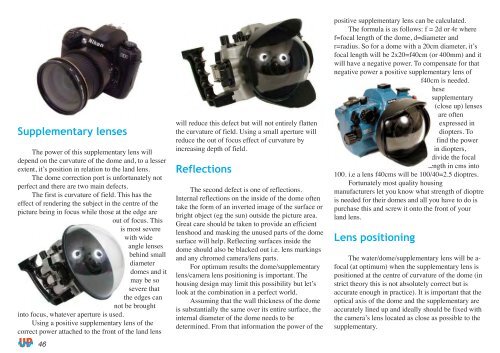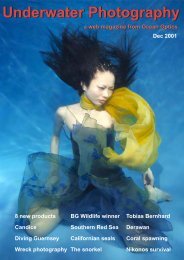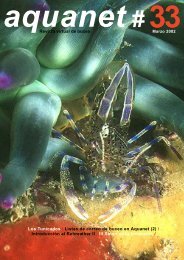Underwater Photography - SENSACIONES.org
Underwater Photography - SENSACIONES.org
Underwater Photography - SENSACIONES.org
You also want an ePaper? Increase the reach of your titles
YUMPU automatically turns print PDFs into web optimized ePapers that Google loves.
Supplementary lenses<br />
The power of this supplementary lens will<br />
depend on the curvature of the dome and, to a lesser<br />
extent, it’s position in relation to the land lens.<br />
The dome correction port is unfortunately not<br />
perfect and there are two main defects.<br />
The first is curvature of field. This has the<br />
effect of rendering the subject in the centre of the<br />
picture being in focus while those at the edge are<br />
out of focus. This<br />
is most severe<br />
with wide<br />
angle lenses<br />
behind small<br />
diameter<br />
domes and it<br />
may be so<br />
severe that<br />
the edges can<br />
not be brought<br />
into focus, whatever aperture is used.<br />
Using a positive supplementary lens of the<br />
correct power attached to the front of the land lens<br />
46<br />
will reduce this defect but will not entirely flatten<br />
the curvature of field. Using a small aperture will<br />
reduce the out of focus effect of curvature by<br />
increasing depth of field.<br />
Reflections<br />
The second defect is one of reflections.<br />
Internal reflections on the inside of the dome often<br />
take the form of an inverted image of the surface or<br />
bright object (eg the sun) outside the picture area.<br />
Great care should be taken to provide an efficient<br />
lenshood and masking the unused parts of the dome<br />
surface will help. Reflecting surfaces inside the<br />
dome should also be blacked out i.e. lens markings<br />
and any chromed camera/lens parts.<br />
For optimum results the dome/supplementary<br />
lens/camera lens positioning is important. The<br />
housing design may limit this possibility but let’s<br />
look at the combination in a perfect world.<br />
Assuming that the wall thickness of the dome<br />
is substantially the same over its entire surface, the<br />
internal diameter of the dome needs to be<br />
determined. From that information the power of the<br />
positive supplementary lens can be calculated.<br />
The formula is as follows: f = 2d or 4r where<br />
f=focal length of the dome, d=diameter and<br />
r=radius. So for a dome with a 20cm diameter, it’s<br />
focal length will be 2x20=f40cm (or 400mm) and it<br />
will have a negative power. To compensate for that<br />
negative power a positive supplementary lens of<br />
f40cm is needed.<br />
These<br />
supplementary<br />
(close up) lenses<br />
are often<br />
expressed in<br />
diopters. To<br />
find the power<br />
in diopters,<br />
divide the focal<br />
length in cms into<br />
100. i.e a lens f40cms will be 100/40=2.5 dioptres.<br />
Fortunately most quality housing<br />
manufacturers let you know what strength of dioptre<br />
is needed for their domes and all you have to do is<br />
purchase this and screw it onto the front of your<br />
land lens.<br />
Lens positioning<br />
The water/dome/supplementary lens will be a-<br />
focal (at optimum) when the supplementary lens is<br />
positioned at the centre of curvature of the dome (in<br />
strict theory this is not absolutely correct but is<br />
accurate enough in practice). It is important that the<br />
optical axis of the dome and the supplementary are<br />
accurately lined up and ideally should be fixed with<br />
the camera’s lens located as close as possible to the<br />
supplementary.
















